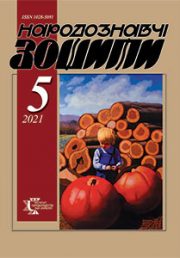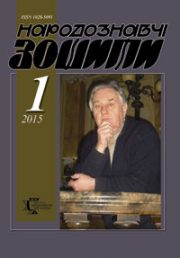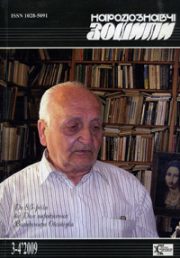The Ethnology Notebooks. 2019, № 6 (150), 1591—1597
UDK784.4
DOI https://doi.org/10.15407/nz2019.06.1591
PYZHIANOVA Nataliia
ORCID: http://orcid.org/0000-0001-9347-6566
Candidate of Art Studies, Associate Professor of
Department of Musicology and vocal-choral art
PavloTychynaUman State Pedagogical University
2,Sadova str., 20300, Uman, Ukraine
Contacts: е-mail: pyzhianova89@gmail.com
Abstract. Introduction. The development of art in the Middle Dnieper region is presented in the works of domestic scientists, in which they analyze specific examples of song genres common in this area and their individual features. The leitmotif of the overwhelming number of scientific works on this topic is the thesis that the main characteristics of folk choral performance were formed in Middle Dnieper, it means in the Central Ukraine.
The relevance of the research: topic is determined not only by its focus on regional musicological exploration, but also by its desire to trace their direct connection to the performing traditions, current trends in Ukrainian choral creativity and factors that directly affect this branch of Ukrainian musical culture.
The aim of the article is to investigate the factors that led to the performing traditions spread of the Central singing group of the Middle Dnieper region in Ukraine. Equally important is the identification of the creative links of the Okhmativskychoir with the leading creative groups of the late XIX — early XX centuries, with the participation of which the Middle Dnieper singing style was popularized and disseminated on the territory of Ukraine.
To determine the peculiarities of the song performance of the Cherkasy region, as a component of Central Ukraine, we applied the method of analogies, historical and comparative, choir, complex approaches.
Achieving this goal led to the need to set and solve such tasks as determining the specifics of folk and singing performance in the region, highlighting the influence of singing traditions of the Okhmativskychoir under the leadership of P. Demutskyi on the formation of folk choirs performing style of Ukraine.
The author identifies two main factors that led to the spread of this tradition, namely, the factor of labor migration and artistic activity of folk groups:
- Seasonal work. The dissemination of the performing traditions of the Middle Dnieper region was facilitated by working conditions, when women-laborers came to work in the field, during work, adopted the performing traditions and spread them to other regions.
- Choral groups touring. The author’s main focus is precisely on the role of the Okhmativskychoir under the leadership of P. Demutskyi, as the most prominent representative of the Middle Dnieper region.
Conclusions. The creative activity of the Okhmativsky choir, the appearance of the authentic folk song on the stage caused such changes that represented a combination of «folk» and «professional». The combination of these singing styles formed a specific model, which was a synthesis of purely folk voices with academic ones, thus forming a folk-academic singing style, widely replicated by various folk choirs.
Keywords: art, group singing tradition, Middle Dnieper region, Okhmativsky village choir, Porfiryi Demutskyi.
Received 19.11.2019
REFERENCES
Murzina, O. (2013). Dnieper in the historical context of the tradition formation. Problems of music ethnology, 9, 12—38 [in Ukrainian].
Pshenichkina, H. (2015). Traditional winter chants of the Right-Bank Cherkasy region: typological and geographical opposition of the Dnipro and Podillya. Problems of music ethnology, 11, 62—76 [in Ukrainian].
Okhmaniuk, V. (2010). Ethnomusical traditions of the Cherkasy Zvenygorod region of the XX century: state of research, prospects. School and tradition, 5, 236—247 [in Ukrainian].
Filatova, A. (2011). History of the research and musical features of the lyric songs of the Chygyryn region. Folk Art and Ethnology, 4, 104—114 [in Ukrainian].
Protasova, S. (2002). Kupala Songs from the Outskirts of the Eastern Podillya (Uman Region and the Suburbs). Problems of music ethnology, 5, 184— 191 [in Ukrainian].
Kvitka, K. (1986). Porfyryi Demutskyi. Selected Articles (Part 2). Kyiv: Musical Ukraine [in Ukrainian].
Yashchenko, L.P. (1957). P.D. Demutskyi: livelihoods and creativity. Kyiv: DVOMML [in Ukrainian].
Bench, O. (2009). Creativity of Porfiryi Demutskyi, Vasyl Verkhovynets, Yaroslav Barnich in the context of folk choral performance. Scientific herald of Odesa National Music Academy of Ukraine named after A.V. Nezhdanova, 10, 9—18 [in Ukrainian].
Ivanytskyi, A. (2015). Ritual musical folklore of the Middle Dnieper region: genre-regional anthology. Vinnytsia: Nova Knyha [in Ukrainian].
Parkhomenko, L., & Hordiichuk, M. (Ed.). (1990). Choral processing of folk songs. In History of Ukrainian music (Vol. 3, pp. 53—87). Kyiv: Naukova dumka [in Ukrainian].
Kostiuk, O., Kalynychenko, A., & Hordiichuk, M. (Ed.). (1990). Chamber — instrumental music. In History of Ukrainian music (Vol. 3, pp. 235—275). Kyiv: Naukova dumka [in Ukrainian].
Pravdiuk, O. (1990). Working folklore and revolutionary song. In History of Ukrainian music (Vol. 3, pp. 12—35). Kyiv: Naukova dumka [in Ukrainian].
Chaban A. (2011). History of the Middle Dnieper region (from ancient times to the end of the XVII century). Cherkasy: Vertykal, published by PE. Kandych [in Ukrainian].
Bench-Shokalo, O.H. (2002). Ukrainian Choral Singing: Updating the Customary Tradition. Kyiv: The Ukrainian World [in Ukrainian].
Pavleno, I. (2013). Reader on Ukrainian folklore performance (with methodological explanations and comments). Kyiv: Publishing and Printing Center «Kyiv University» [in Ukrainian].
Skoptsova, O. (2005). Formation and features of folk choral performance development in Ukraine (end of XIX — XX centuries). (PhD of studies diss. abstr.). Kyiv [in Ukrainian].
Rozhok, O. (2014). Choir, enveloped in people’s love. The Bulletin of Tchaikovsky National Music Academy of Ukraine, 3, 116—123 [in Ukrainian].
Pyzhianova, N. (2014). Establishment of the Okhmatov village choir of Porfiryi Demutskyi. The Ethnology Notebooks (art series), 6, 1581—1585 [in Ukrainian].
Chykalenko, Ye. (n. d.). Memories of 1861—1907. Retrieved from: http://histpol.pl.ua/ru/?option=com_content& view=article&id=12067 (Last accessed: 15.02.2017) [in Ukrainian].
Parkhomenko, L. (2015). Artistic approbation (to the 140th anniversary of the debut in Porfiryi Demutskyi’s folklore). Ukrainian Art Studies: Materials, Research, Reviews, 15, 106—115 [in Ukrainian].
Demutskyi, P. (1927). Curiculum vitae. Institute of Manuscripts of the National V.I. Vernadskyi Library of Ukraine. F. 50. Op. 502 [in Ukrainian].
Choir studio of K. Stetsenko documents on the activities of the studio for 1922—1925 (n. d.). Originals and copies. Institute of Manuscripts of the National V.I. Vernadskyi Library of Ukraine. MTL. F. 50. Op. 727 [in Ukrainian].
Bondar, Ye. (2013). Genesis of professional choral performance: from its origins to the XVIII century. Scientific herald of Tchaikovsky National Music Academy of Ukraine, 107, 103—115 [in Ukrainian].






